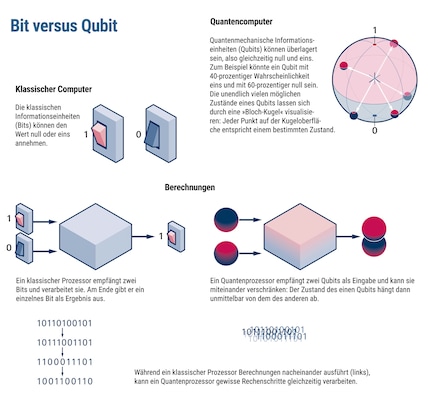
Efficient quantum software for future quantum computers
Researchers have developed a quantum algorithm that can simulate the behaviour of tiny particles under the influence of heat. This could open up new avenues for medicines, batteries and materials.
A computer without software would just be a pile of electronics with no function. Quantum computers are no different. However, while the public usually only discusses advances in hardware, a no less important key to the utilisation of quantum computers lies in the software - in other words, in the algorithms that error correction methods and the programming languages that make it possible to utilise the complex quantum effects in the first place. An American research group led by Chi-Fang Chen from the California Institute of Technology has now developed a quantum algorithm that can be used to simulate the smallest particles under the influence of heat. The algorithm is the first of its kind and could provide a basis for further applications, the researchers write in the study in the specialist journal «Nature».
Interactions between particles at the molecular level are responsible for how drugs work in the body or how mobile phones can be charged. However, as the laws of quantum mechanics apply here, conventional computers can only simulate these processes incompletely or at great computational expense. The possibilities of using quantum mechanical simulations to find new drugs, better batteries and innovative materials are therefore limited. This is why many hopes are pinned on quantum computers. They are themselves a quantum system, and this eliminates the need for a lot of computing work. However, as long as there is no universal, error-corrected quantum computer, it remains unclear what is possible and feasible in reality.
In the current study, the authors mathematically derive that their algorithm can theoretically be executed on a quantum computer and maps basic properties of the system to be simulated. The quantum algorithm presented is intended to describe how the energy in a physical system changes when it comes into contact with heat, i.e. with energy. Energy can influence the properties of a system. The research team's approach is based on a method already familiar from classical simulations: the Markov chain Monte Carlo method. This is a method for approximating complicated probability distributions by generating a chain of random samples. Each new sample depends only on the previous state, so that even high-dimensional or analytically difficult to handle distributions can be analysed efficiently.

Source: Spektrum der Wissenschaft / Emde-Grafik (Ausschnitt)
Two quantum computer scientists asked for their opinions by the Science Media Centre rate the concept as very promising. For example, Mario Berta from the Rheinisch-Westfälische Technische Hochschule Aachen says that the structure of the proposed quantum algorithm is conceptually new and is at the highest scientific level. «Compared to many previous employees in the field of quantum simulations, the study goes much further, as it opens up a new direction with great potential.» The algorithm presented could close an existing gap by enabling efficient quantum simulation of equilibrium states for the first time - classical methods have reached fundamental limits here. It is a good candidate for an initial test run on a future, error-corrected quantum computer.
Hannes Pichler, Professor of Theoretical Quantum Physics at the University of Innsbruck, says that the new quantum algorithm has «properties that are conceptually interesting, as they establish clear analogies to the important classical algorithms». In addition, it is clearly shown that the necessary dynamics can in principle be realised efficiently on a quantum computer. Nevertheless, he cautions: «The gap between the hardware requirements of these algorithms and the current state of the art remains considerable.» This shows that hardware is just as important as software, because without it, even the most sophisticated algorithm remains just theory.
Spectrum of Science
We are partners of Spektrum der Wissenschaft and want to make well-founded information more accessible to you. Follow Spektrum der Wissenschaft if you like the articles.
Original article on Spektrum.de
Experts from science and research report on the latest findings in their fields – competent, authentic and comprehensible.
From the latest iPhone to the return of 80s fashion. The editorial team will help you make sense of it all.
Show all